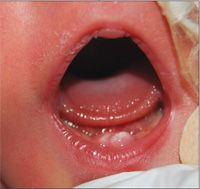Neonatal Teeth
Seven days after birth, a female infant was noted to have 2 mandibular central incisor teeth. The teeth were firmly fixed in the gums, and the infant was growing well on breast milk. Neonatal teeth (which appear during the first 30 days of life) are about 3 times more common than natal teeth (which are present at birth), although both are relatively rare.

Seven days after birth, a female infant was noted to have 2 mandibular central incisor teeth. The teeth were firmly fixed in the gums, and the infant was growing well on breast milk. Neonatal teeth (which appear during the first 30 days of life) are about 3 times more common than natal teeth (which are present at birth), although both are relatively rare. Most natal and neonatal teeth are isolated findings; however, they may be associated with an underlying condition (eg, Ellis-van Creveld syndrome, Hallermann-Streiff syndrome, Pierre Robin syndrome, or Jadassohn-Lewandowski syndrome) and are frequently present in patients with a cleft palate.1 There is no sex predilection among infants with neonatal or natal teeth. About 15% of affected infants have a sibling or parent with a similar history.1,2
Mandibular primary incisors are the most common type of neonatal teeth. Depending on their firmness and location, the teeth may irritate the infant's tongue or the nursing mother's breast and can result in poor feeding. In some infants, smoothing the rough edges of the tooth may solve the problem. An excessively loose natal tooth is often removed in the hospital before the infant is released home because of the risk of aspiration.1 Generally, if there are no feeding difficulties and no risk of aspiration, the tooth is preserved. When removal is unnecessary, as was the case in this infant, advise parents to monitor the teeth for looseness and the gums and tongue for any irritation. Parents can keep the teeth clean by gently wiping them with a wet cloth.2
References:
REFERENCES:
1.
Kapner M. Natal teeth. August 8, 2007. Available at:
http://www.nlm.nih.gov/medlineplus/ency/article/003268.htm
. Accessed November 14, 2007.
2.
Wright JT. Normal formation and development defects of the human dentition.
Pediatr Clin North Am.
2000;47:975-1000.